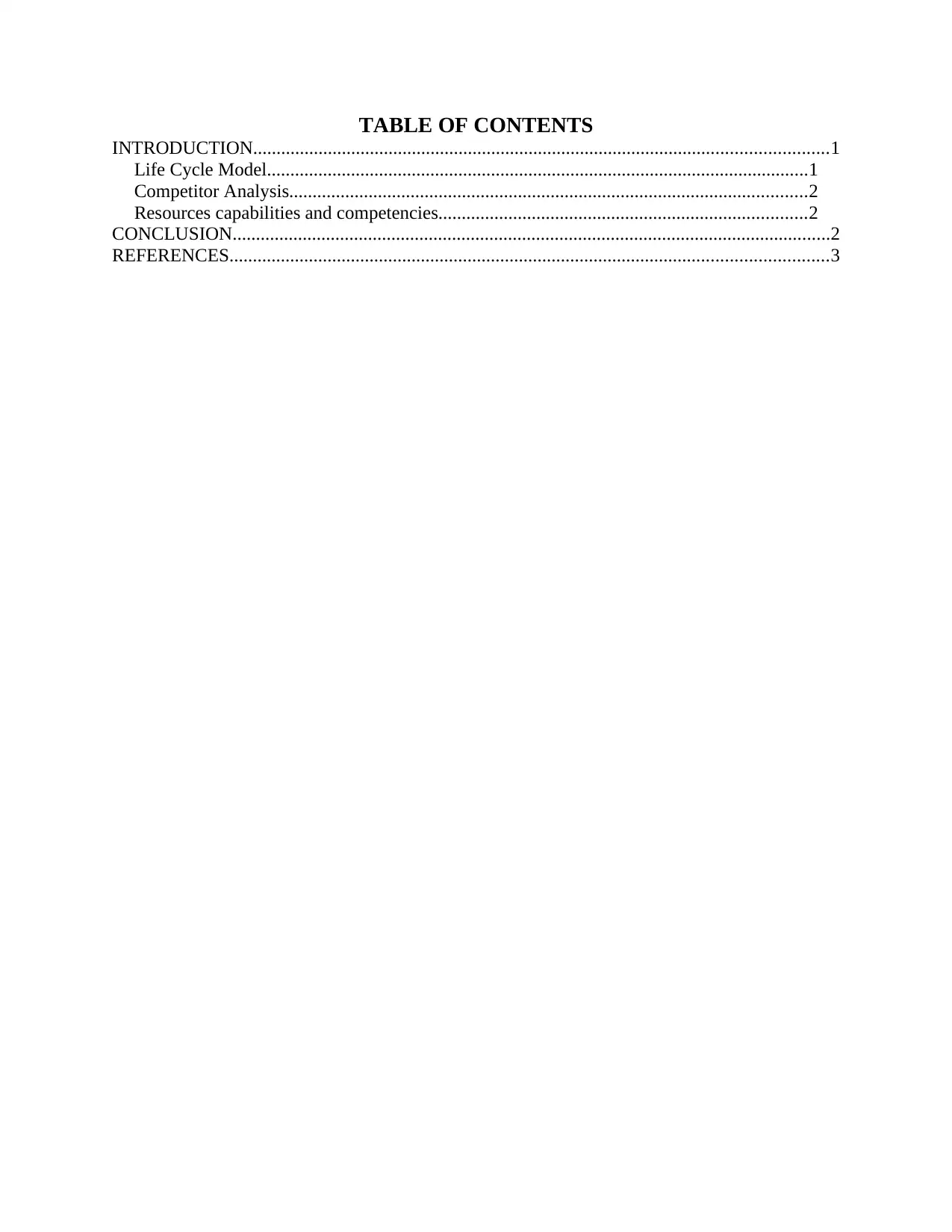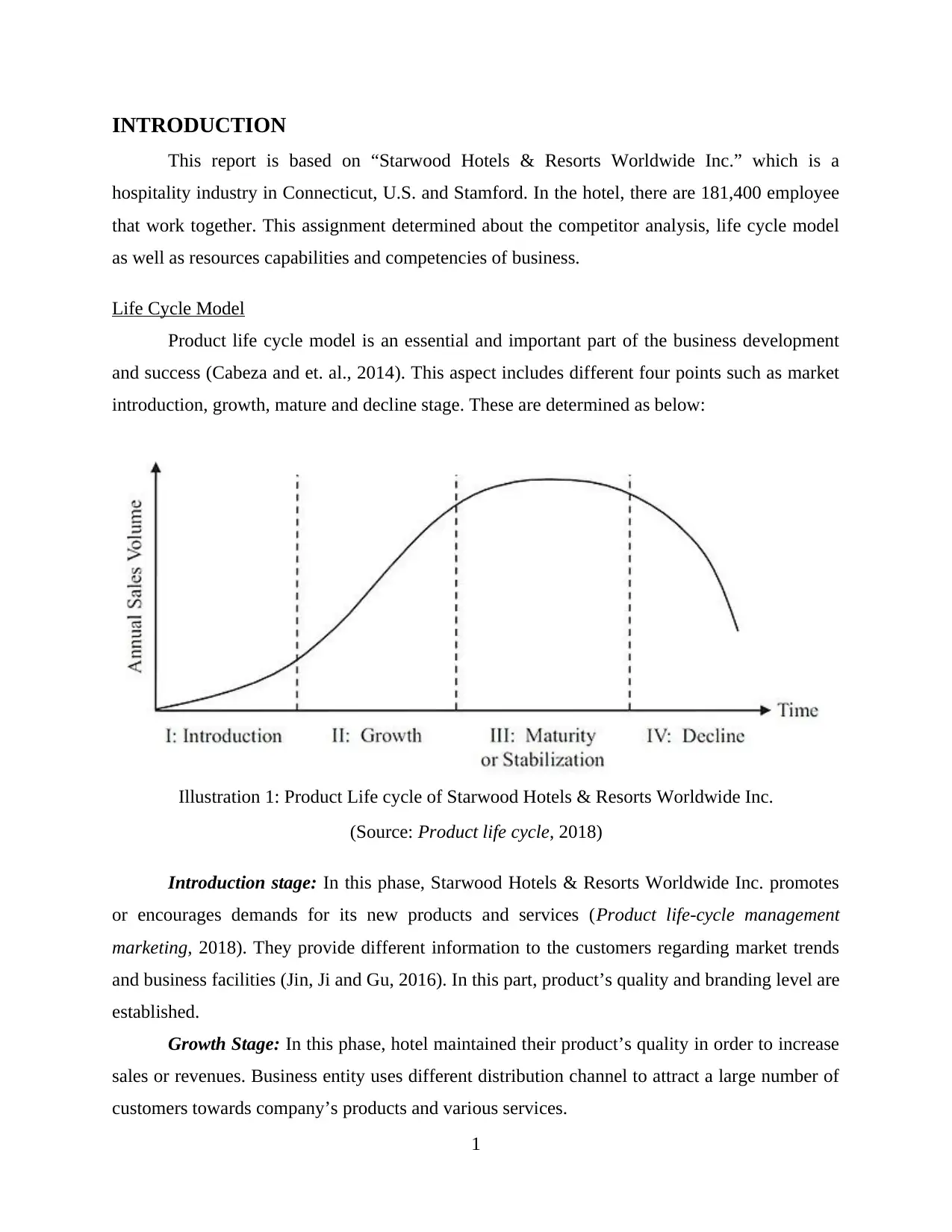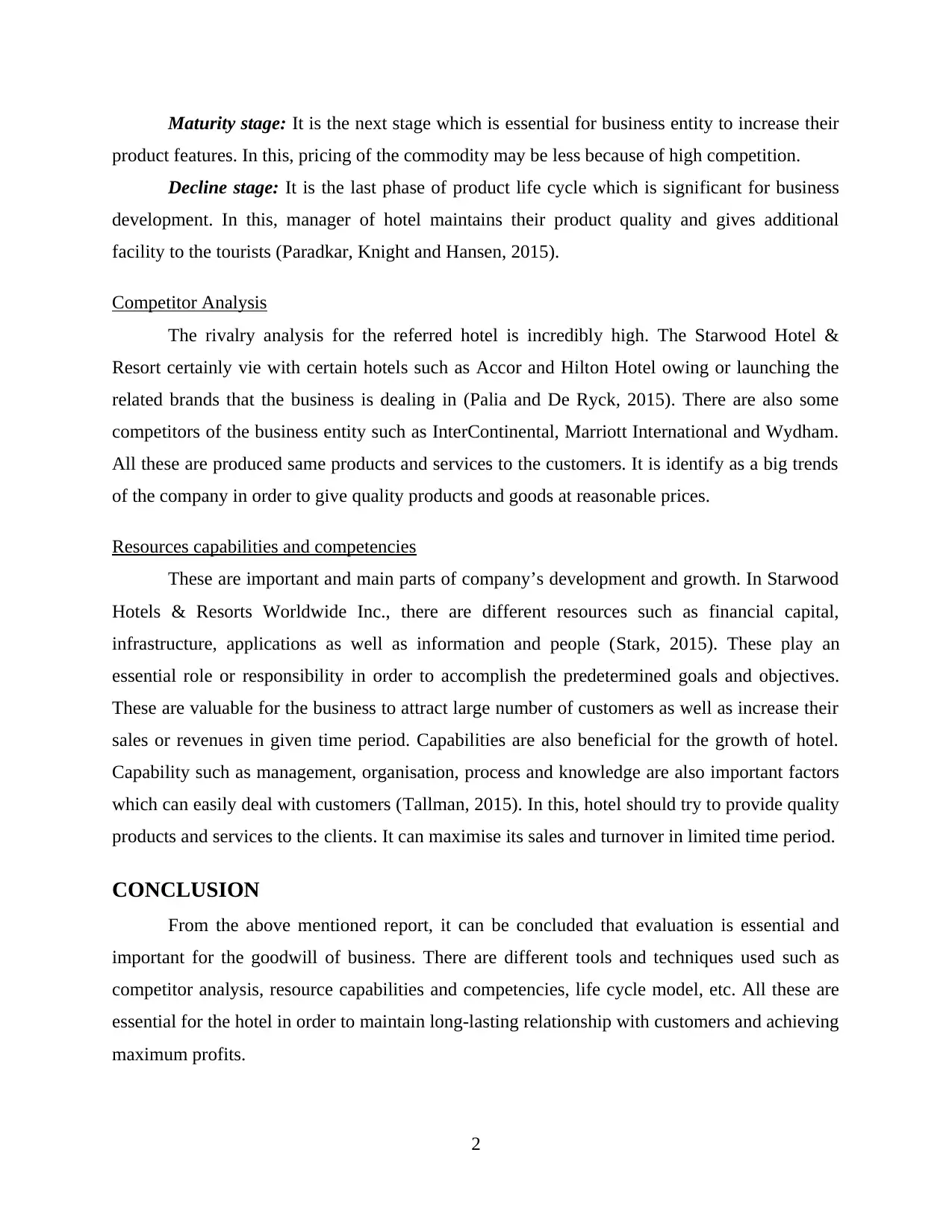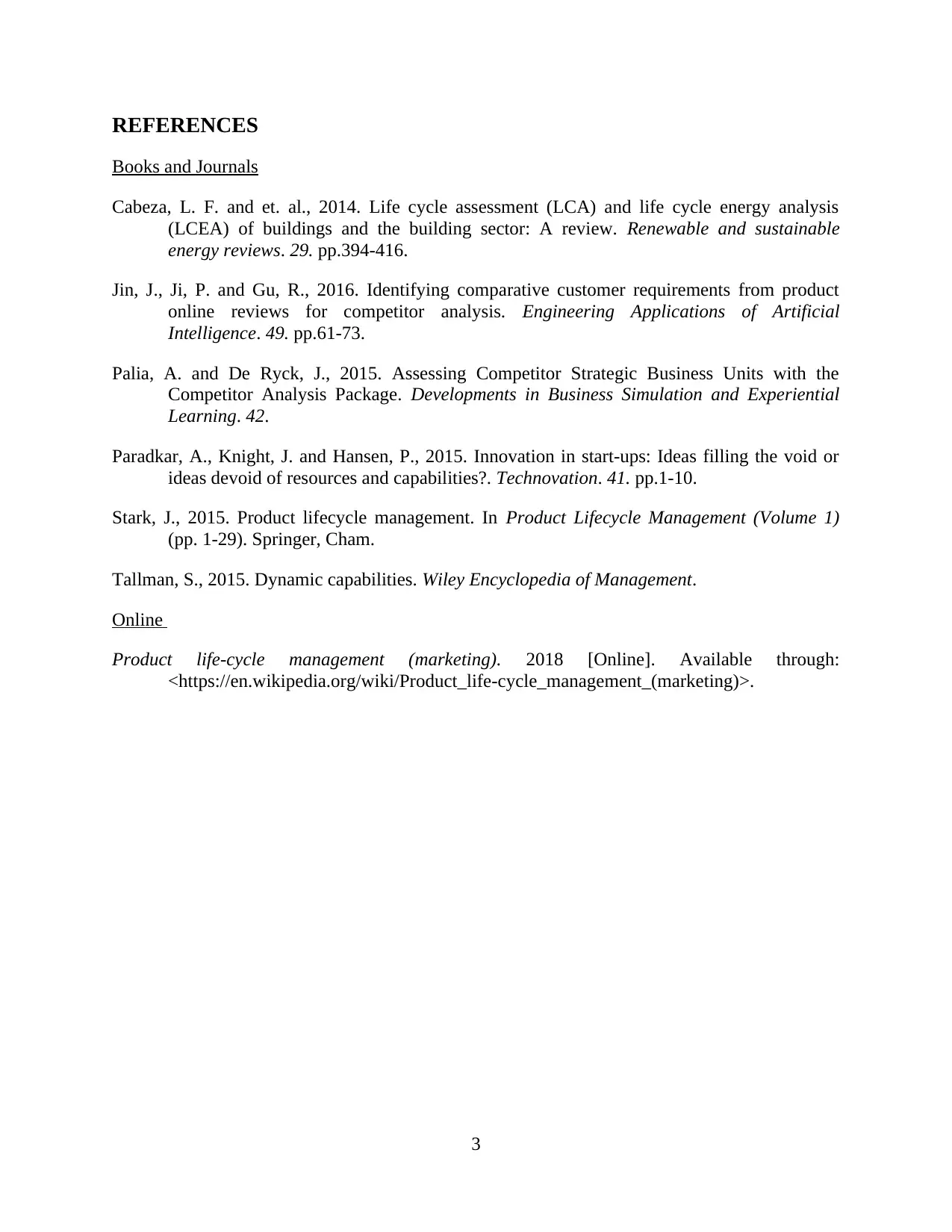Business Report: Starwood Hotels & Resorts Worldwide Inc. Analysis
VerifiedAdded on 2020/09/17
|5
|944
|35
Report
AI Summary
This report provides a detailed analysis of Starwood Hotels & Resorts Worldwide Inc., focusing on its business strategies and market position. The report begins with an introduction to the company and its operations, followed by an examination of the product life cycle model, highlighting the introduction, growth, maturity, and decline stages. A thorough competitor analysis is conducted, identifying key rivals such as Accor, Hilton Hotel, InterContinental, Marriott International, and Wydham, and assessing their impact on Starwood's market share. Furthermore, the report explores the company's resources, capabilities, and competencies, including financial capital, infrastructure, information, and human resources, and their role in achieving business objectives and attracting customers. The conclusion summarizes the importance of these factors for business goodwill and long-term customer relationships.

ANALYSIS
Paraphrase This Document
Need a fresh take? Get an instant paraphrase of this document with our AI Paraphraser

TABLE OF CONTENTS
INTRODUCTION...........................................................................................................................1
Life Cycle Model....................................................................................................................1
Competitor Analysis...............................................................................................................2
Resources capabilities and competencies...............................................................................2
CONCLUSION................................................................................................................................2
REFERENCES................................................................................................................................3
INTRODUCTION...........................................................................................................................1
Life Cycle Model....................................................................................................................1
Competitor Analysis...............................................................................................................2
Resources capabilities and competencies...............................................................................2
CONCLUSION................................................................................................................................2
REFERENCES................................................................................................................................3

INTRODUCTION
This report is based on “Starwood Hotels & Resorts Worldwide Inc.” which is a
hospitality industry in Connecticut, U.S. and Stamford. In the hotel, there are 181,400 employee
that work together. This assignment determined about the competitor analysis, life cycle model
as well as resources capabilities and competencies of business.
Life Cycle Model
Product life cycle model is an essential and important part of the business development
and success (Cabeza and et. al., 2014). This aspect includes different four points such as market
introduction, growth, mature and decline stage. These are determined as below:
(Source: Product life cycle, 2018)
Introduction stage: In this phase, Starwood Hotels & Resorts Worldwide Inc. promotes
or encourages demands for its new products and services (Product life-cycle management
marketing, 2018). They provide different information to the customers regarding market trends
and business facilities (Jin, Ji and Gu, 2016). In this part, product’s quality and branding level are
established.
Growth Stage: In this phase, hotel maintained their product’s quality in order to increase
sales or revenues. Business entity uses different distribution channel to attract a large number of
customers towards company’s products and various services.
1
Illustration 1: Product Life cycle of Starwood Hotels & Resorts Worldwide Inc.
This report is based on “Starwood Hotels & Resorts Worldwide Inc.” which is a
hospitality industry in Connecticut, U.S. and Stamford. In the hotel, there are 181,400 employee
that work together. This assignment determined about the competitor analysis, life cycle model
as well as resources capabilities and competencies of business.
Life Cycle Model
Product life cycle model is an essential and important part of the business development
and success (Cabeza and et. al., 2014). This aspect includes different four points such as market
introduction, growth, mature and decline stage. These are determined as below:
(Source: Product life cycle, 2018)
Introduction stage: In this phase, Starwood Hotels & Resorts Worldwide Inc. promotes
or encourages demands for its new products and services (Product life-cycle management
marketing, 2018). They provide different information to the customers regarding market trends
and business facilities (Jin, Ji and Gu, 2016). In this part, product’s quality and branding level are
established.
Growth Stage: In this phase, hotel maintained their product’s quality in order to increase
sales or revenues. Business entity uses different distribution channel to attract a large number of
customers towards company’s products and various services.
1
Illustration 1: Product Life cycle of Starwood Hotels & Resorts Worldwide Inc.
⊘ This is a preview!⊘
Do you want full access?
Subscribe today to unlock all pages.

Trusted by 1+ million students worldwide

Maturity stage: It is the next stage which is essential for business entity to increase their
product features. In this, pricing of the commodity may be less because of high competition.
Decline stage: It is the last phase of product life cycle which is significant for business
development. In this, manager of hotel maintains their product quality and gives additional
facility to the tourists (Paradkar, Knight and Hansen, 2015).
Competitor Analysis
The rivalry analysis for the referred hotel is incredibly high. The Starwood Hotel &
Resort certainly vie with certain hotels such as Accor and Hilton Hotel owing or launching the
related brands that the business is dealing in (Palia and De Ryck, 2015). There are also some
competitors of the business entity such as InterContinental, Marriott International and Wydham.
All these are produced same products and services to the customers. It is identify as a big trends
of the company in order to give quality products and goods at reasonable prices.
Resources capabilities and competencies
These are important and main parts of company’s development and growth. In Starwood
Hotels & Resorts Worldwide Inc., there are different resources such as financial capital,
infrastructure, applications as well as information and people (Stark, 2015). These play an
essential role or responsibility in order to accomplish the predetermined goals and objectives.
These are valuable for the business to attract large number of customers as well as increase their
sales or revenues in given time period. Capabilities are also beneficial for the growth of hotel.
Capability such as management, organisation, process and knowledge are also important factors
which can easily deal with customers (Tallman, 2015). In this, hotel should try to provide quality
products and services to the clients. It can maximise its sales and turnover in limited time period.
CONCLUSION
From the above mentioned report, it can be concluded that evaluation is essential and
important for the goodwill of business. There are different tools and techniques used such as
competitor analysis, resource capabilities and competencies, life cycle model, etc. All these are
essential for the hotel in order to maintain long-lasting relationship with customers and achieving
maximum profits.
2
product features. In this, pricing of the commodity may be less because of high competition.
Decline stage: It is the last phase of product life cycle which is significant for business
development. In this, manager of hotel maintains their product quality and gives additional
facility to the tourists (Paradkar, Knight and Hansen, 2015).
Competitor Analysis
The rivalry analysis for the referred hotel is incredibly high. The Starwood Hotel &
Resort certainly vie with certain hotels such as Accor and Hilton Hotel owing or launching the
related brands that the business is dealing in (Palia and De Ryck, 2015). There are also some
competitors of the business entity such as InterContinental, Marriott International and Wydham.
All these are produced same products and services to the customers. It is identify as a big trends
of the company in order to give quality products and goods at reasonable prices.
Resources capabilities and competencies
These are important and main parts of company’s development and growth. In Starwood
Hotels & Resorts Worldwide Inc., there are different resources such as financial capital,
infrastructure, applications as well as information and people (Stark, 2015). These play an
essential role or responsibility in order to accomplish the predetermined goals and objectives.
These are valuable for the business to attract large number of customers as well as increase their
sales or revenues in given time period. Capabilities are also beneficial for the growth of hotel.
Capability such as management, organisation, process and knowledge are also important factors
which can easily deal with customers (Tallman, 2015). In this, hotel should try to provide quality
products and services to the clients. It can maximise its sales and turnover in limited time period.
CONCLUSION
From the above mentioned report, it can be concluded that evaluation is essential and
important for the goodwill of business. There are different tools and techniques used such as
competitor analysis, resource capabilities and competencies, life cycle model, etc. All these are
essential for the hotel in order to maintain long-lasting relationship with customers and achieving
maximum profits.
2
Paraphrase This Document
Need a fresh take? Get an instant paraphrase of this document with our AI Paraphraser

REFERENCES
Books and Journals
Cabeza, L. F. and et. al., 2014. Life cycle assessment (LCA) and life cycle energy analysis
(LCEA) of buildings and the building sector: A review. Renewable and sustainable
energy reviews. 29. pp.394-416.
Jin, J., Ji, P. and Gu, R., 2016. Identifying comparative customer requirements from product
online reviews for competitor analysis. Engineering Applications of Artificial
Intelligence. 49. pp.61-73.
Palia, A. and De Ryck, J., 2015. Assessing Competitor Strategic Business Units with the
Competitor Analysis Package. Developments in Business Simulation and Experiential
Learning. 42.
Paradkar, A., Knight, J. and Hansen, P., 2015. Innovation in start-ups: Ideas filling the void or
ideas devoid of resources and capabilities?. Technovation. 41. pp.1-10.
Stark, J., 2015. Product lifecycle management. In Product Lifecycle Management (Volume 1)
(pp. 1-29). Springer, Cham.
Tallman, S., 2015. Dynamic capabilities. Wiley Encyclopedia of Management.
Online
Product life-cycle management (marketing). 2018 [Online]. Available through:
<https://en.wikipedia.org/wiki/Product_life-cycle_management_(marketing)>.
3
Books and Journals
Cabeza, L. F. and et. al., 2014. Life cycle assessment (LCA) and life cycle energy analysis
(LCEA) of buildings and the building sector: A review. Renewable and sustainable
energy reviews. 29. pp.394-416.
Jin, J., Ji, P. and Gu, R., 2016. Identifying comparative customer requirements from product
online reviews for competitor analysis. Engineering Applications of Artificial
Intelligence. 49. pp.61-73.
Palia, A. and De Ryck, J., 2015. Assessing Competitor Strategic Business Units with the
Competitor Analysis Package. Developments in Business Simulation and Experiential
Learning. 42.
Paradkar, A., Knight, J. and Hansen, P., 2015. Innovation in start-ups: Ideas filling the void or
ideas devoid of resources and capabilities?. Technovation. 41. pp.1-10.
Stark, J., 2015. Product lifecycle management. In Product Lifecycle Management (Volume 1)
(pp. 1-29). Springer, Cham.
Tallman, S., 2015. Dynamic capabilities. Wiley Encyclopedia of Management.
Online
Product life-cycle management (marketing). 2018 [Online]. Available through:
<https://en.wikipedia.org/wiki/Product_life-cycle_management_(marketing)>.
3
1 out of 5
Related Documents
Your All-in-One AI-Powered Toolkit for Academic Success.
+13062052269
info@desklib.com
Available 24*7 on WhatsApp / Email
![[object Object]](/_next/static/media/star-bottom.7253800d.svg)
Unlock your academic potential
Copyright © 2020–2025 A2Z Services. All Rights Reserved. Developed and managed by ZUCOL.





